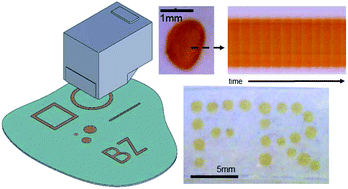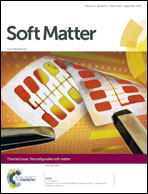Autonomic composite hydrogels by reactive printing: materials and oscillatory response†
Abstract
Autonomic materials are those that automatically respond to a change in environmental conditions, such as temperature or chemical composition. While such materials hold incredible potential for a wide range of uses, their implementation is limited by the small number of fully-developed material systems. To broaden the number of available systems, we have developed a post-functionalization technique where a reactive Ru catalyst ink is printed onto a non-responsive polymer substrate. Using a succinimide–amine coupling reaction, patterns are printed onto co-polymer or biomacromolecular films containing primary amine functionality, such as polyacrylamide (PAAm) or poly-N-isopropyl acrylamide (PNIPAAm) copolymerized with poly-N-(3-Aminopropyl)methacrylamide (PAPMAAm). When the films are placed in the Belousov–Zhabotinsky (BZ) solution medium, the reaction takes place only inside the printed nodes. In comparison to alternative BZ systems, where Ru-containing monomers are copolymerized with base monomers, reactive printing provides facile tuning of a range of hydrogel compositions, as well as enabling the formation of mechanically robust composite monoliths. The autonomic response of the printed nodes is similar for all matrices in the BZ solution concentrations examined, where the period of oscillation decreases in response to increasing sodium bromate or nitric acid concentration. A temperature increase reduces the period of oscillations and temperature gradients are shown to function as pace-makers, dictating the direction of the autonomic response (chemical waves).

- This article is part of the themed collection: Reconfigurable soft matter

 Please wait while we load your content...
Please wait while we load your content...